Maintaining a clean sand bed is essential to the health of your reef tank. Natural processes aren’t always able to handle the amount of waste produced by aquariums.
Fortunately, there are simple ways to deal with this problem. Using a syphon vacuum to clean regularly during water changes is one of the easy and efficient methods out of many natural ways to keep fish tank clean. Adding beneficial animals like Sand Sifting Gobies or employing snails to clean the sand are other options for “how to keep sand bed clean in reef tank”!
By using these techniques which include the best sand bed cleaner reef, you can keep your reef tank healthy and free of contaminants.
Disclosure: This article contains affiliate links. When you follow a link to purchase the products, I sometime earn a commission, at no additional cost to you. Read my full disclosure here
How to Keep Sand Bed Clean in Reef Tank?
If your aquarium is losing its aesthetically pleasing look due to a dirty sand bed, we think it’s time for cleaning sand bed in reef tank.
Here, we have brought you some amazing natural ways to keep fish tank clean along with some artificial methods for “how to keep sand bed clean in reef tank,” so have a look!
Artificial Ways for Cleaning Sad Bed in Reef Tank
Method 1: Cleaning Sand Bed in Reef Tank with Syphon Vacuum
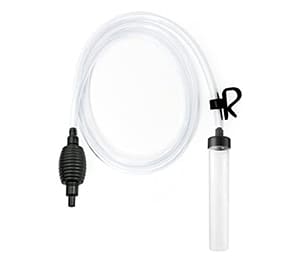
Step 1: Assemble Your Equipment
Invest in a Medium-sized, 9-inch Aqueon Aquarium Syphon Vacuum Gravel Cleaner. Make sure your aquarium syphon comes with both a hard plastic tube and soft hose tubing.
Step 2: Get Ready for a Water Swap
Consider using this sand cleaning technique in conjunction with a routine water change. During the water change, the water you remove will be replaced.
Step 3: Let the syphon begin
Join the hard plastic tube to the soft hose tubing. To start the syphon and transfer water from the tank into a container, use the syphon device.
Step 4: Start Cleaning
Place the tube over the sand bed once the syphon is operating smoothly and without air. Create suction by gently pressing the tube into the sand to draw sand into tube.
Step 5: Take Your Time
To thoroughly clean the sand bed without upsetting the good bacteria and other organisms, go slowly. Before continuing, make sure you have cleaned the entire area.
Step 6: Finish the Water Change
After cleaning sand bed in reef tank, carry out your usual water change schedule. To restock the tank, add fresh seawater.
Step 7: Modify Frequency
Based on the state of your sand bed, decide how often to clean it. To get the right level of cleanliness on heavily soiled beds, repeat the procedure as necessary.
Method 2: Filter Sock Vacuum Syphoning
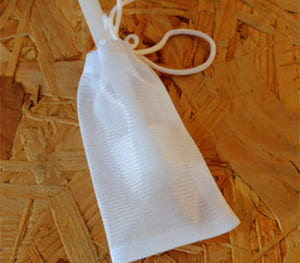
Step 1: Use Syphon Vacuum
As mentioned in the first method, start cleaning sand bed in reef tank by using an Aqueon Aquarium Syphon Vacuum Gravel Cleaner.
Step 2: Pour into a filter sock
When the return pumps are running, channel the water into a filter sock in your sump rather than out into another container. This makes it possible to syphon continuously over a wide area.
Step 3: Unplug the syphon and wash the filter sock
Break the syphon and take out the filter sock for cleaning once the cleaning is finished. Deep, uncleaned sand beds should be handled carefully because dissolved organic waste can pass through the filter sock and into the water column.
Method 3: Shaking the Sand for Continual Upkeep
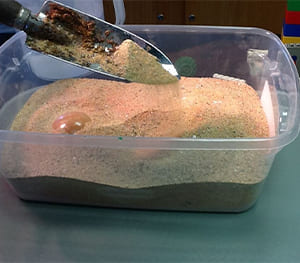
Step 1: Select a Stirring Instrument
For this technique, use a long aquarium tong or other suitable tool to gently mix the sand bed.
Step 2: Stir the Sand Gently
Gently mix up the sand bed with the selected tool after inserting it. This technique works well for weekly upkeep of a sand bed that is generally tidy and well-maintained.
Step 3: Keep an eye on cloudiness
After stirring, the water should appear slightly hazy; this usually goes away in an hour or so. This technique should not be applied to dirty, deep sand beds because it can discharge waste into the water column.
Method 4: Using Micro Bubble Scrubbing to Stir
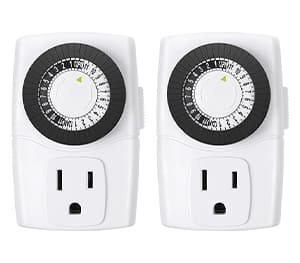
Step 1: Carry Out the Previous Actions
To begin the process of cleaning sand bed in reef tank, proceed in the same manner as described earlier, stirring the sand bed with a tool.
Step 2: Present Microbubbles
You can produce microbubbles by running the sump’s water level a little below normal or by partially exposing a powerhead to air. Waste will attract microbubbles in the water column.
Step 3: Let Microbubbles Remove Trash
Microbubbles will transport waste to the top of the tank and down into the sump after stirring. To properly process the waste that has been collected, make sure to empty the skimmer and change the filter socks.
Method 5: Rinsing or replacing the sand
Exercise caution when using this method for cleaning sand bed in reef tank especially on deep, old sand beds, to prevent upsetting trapped waste and having a negative impact on the water column.
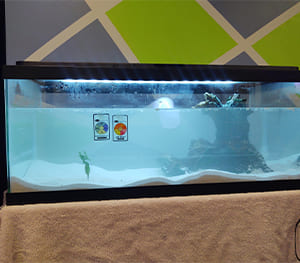
Step 1: Assemble Equipment
Select an appropriate scoop to empty the tank of sand. Set up a 5-gallon bucket or other container to hold the sand that has been removed.
Step2: Turn Off the Tank’s Flow
To avoid agitating waste and contaminating the water, stop all flow within the tank.
Step 3: Sand Removal by Hand
Sand in the aquarium can be gently scooped out and removed in the desired quantity. Sand removal should be stored in a 5-gallon bucket.
Step 4: Select Rinsing or Replacement
Choose whether to rinse the current sand or add fresh sand to replace the removed sand.
Step 5: Swap out for fresh sand
To lessen cloudiness, rinse the newly added sand several times. Take care not to disturb the water as you gradually add the new sand to the tank.
Step 6: Optionally Rinse the Existing Sand
Take the removed sand outside or to a washbasin if you plan to rinse it. After stirring the sand in the water-filled bucket, drain the water. Continue doing this until the water appears fairly clear.
Step 7: Put Sand Back in the Tank
After the sand has been thoroughly cleaned, carefully return it to the tank from which it was taken. As this technique of cleaning sand bed in reef tank is slightly complicated, take care when handling it to prevent clouding,
Natural Ways for Cleaning Sand Bed in Reef Tank
1. Nassarius Snails for Sand Cleaning
Think of natural way to keep fish tank clean, nassarius snails are the first for tank cleaning that comes to our mind. As efficient scavengers and members of the cleanup team, Nassarius snails help maintain the sand bed’s cleanliness and aeration. When they detect food nearby, they emerge from their sand burrows.
They are interesting to watch and contribute to the diversity of the tank, even though such fish for tank cleaning are not the most effective at cleaning sand.
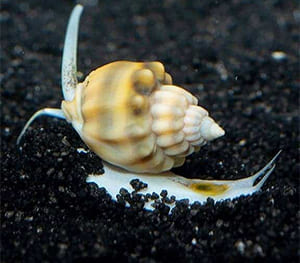
2. Babylon Snail for Sand Cleaning
Another option for natural way to keep fish tank clean is Babylon snail. In reef tanks, Babylon snails—also known as Tiger Nassarius snails—function similarly to Nassarius snails.
These bigger, nocturnal, waste-eating snails efficiently flip the sand bed and keep it tidy. Although the attractive appearance of fish for tank cleaning enhances the tank’s appeal, care should be taken in case they come into contact with other tank specimens.
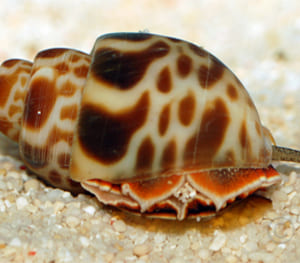
3. Sand Sifting Starfish
In reef aquariums, Sand Sifting Starfish help with cleanup. They burrow in the sand, keeping it oxygenated and preventing waste from settling down. These fish for tank cleaning are peaceful and aesthetically pleasing too!
Their movements aid in maintaining a healthy environment even though they don’t actually clean the sand. These starfish are important markers for tank health because they also serve as an early warning system for changes in the chemistry of the water. Hence, they are an amazing contributor to natural way to keep fish tank clean.
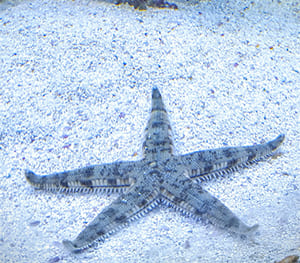
4. Cerith Snail for Cleaning Sand
With a longer spiral shell, cerith snails are useful contributors to a reef cleanup team. Even though such fish for tank cleaning burrow in the sand bed, more of them are required to effectively clean the sand because of their small size.
These calm snails help maintain a clean and healthy environment in the reef tank by assisting with waste management and algae control.
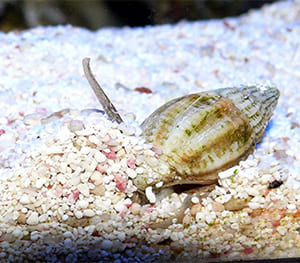
5. Gobies that Sift Sand
The last natural way to keep fish tank clean we are going to discuss is the Gobies! Sorting Sand Gobies are an excellent option for keeping the sand bed of a reef aquarium tidy. They are generally calm tank companions and come in varieties.
During the day, these fish for tank cleaning effectively filter mouthfuls of algae, pods, and waste from the sand. Some might even develop amusing symbiotic connections with pistol shrimp.
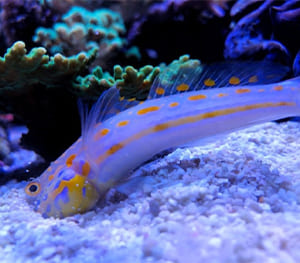
Conclusion
With its diligent and effective sand-cleaning habits, the Diamond Goby is our first choice when it comes to natural way to keep fish tank clean. It’s a great addition to a reef aquarium because of its peaceful nature and preference for burrowing.
In summary, a healthy sand bed is necessary for a flourishing tank. The general health and vibrancy of your aquatic environment are enhanced by using appropriate cleaning techniques, be it the natural way to keep fish tank clean or some artificial techniques. So, choose wisely!



